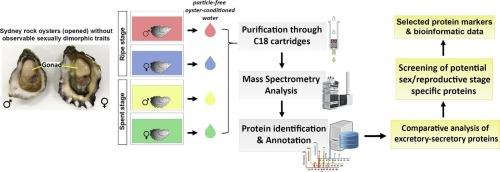悉尼岩牡蛎调温水体性别及生殖蛋白生物标志物的鉴定
IF 3.9
1区 农林科学
Q1 FISHERIES
引用次数: 0
摘要
悉尼岩牡蛎(SRO), Saccostrea glomerata,是澳大利亚最重要的水产养殖物种之一,改进生产技术对于创造可靠、可持续的养殖方式和提高盈利能力至关重要。由于亲鱼没有表现出任何外部性别二态性,目前的性别鉴定方法依赖于损害亲鱼完整性的侵入性和破坏性技术,因此性别鉴定是一项重大挑战。因此,本研究调查了sro是否分泌可用于性别鉴定的性别和生殖阶段特异性符号化学蛋白谱。在对不同性别的牡蛎在两个不同的生殖阶段(成熟和消耗)的水进行蛋白质组学分析后,我们证明sro确实分泌不同的性别和生殖阶段蛋白质谱。功能注释显示,这些分泌蛋白可能参与代谢过程、免疫和化学通讯。此外,半定量分析有助于确定候选女性特异性蛋白质生物标志物,进一步研究的主要目标是诱惑蛋白和byssal蛋白-3样蛋白。这两种蛋白在牡蛎的消化腺中均有高表达,在雌性的条件水中含量丰富。总之,本研究已经确定sro释放独特的蛋白质谱,其中一些可能被用作生物标志物,非侵入性地推断性别和生殖阶段。这一基础知识为开发无创检测牡蛎性别、繁殖阶段和免疫状态的新方法提供了基础,从而为水产养殖业的运营提供了显著的好处。本文章由计算机程序翻译,如有差异,请以英文原文为准。

Identification of sex and reproductive protein biomarkers in conditioned water of the Sydney rock oyster
The Sydney rock oyster (SRO), Saccostrea glomerata, is one of the most important aquaculture species in Australian, and improving production techniques is essential for creating reliable, sustainable farming practices with increased profitability. Broodstock sex identification is a significant challenge since they do not display any external sexual dimorphism and current sex identification approaches rely on invasive and destructive techniques that compromise broodstock integrity. Therefore, this study investigated whether SROs secrete sex and reproductive stage-specific semiochemical protein profiles that could be used for sex identification. Following proteomic analysis of oyster-conditioned water at two different reproductive stages (ripe and spent) for each sex, we demonstrate that SROs do secrete a distinct sex and reproductive stage protein profile. Functional annotation revealed these secreted proteins are potentially involved in metabolic processes, immunity and chemical communication. Furthermore, semi-quantitative analysis facilitated identification of candidate female-specific protein biomarkers, with primary targets for further investigation being temptin and byssal protein-3-like proteins. Both proteins showed high gene expression in the oyster's digestive gland and were abundant in the conditioned water of females. In conclusion, this study has established that SROs release distinctive protein profiles, some of which may be utilized as biomarkers to infer sex and reproductive stage non-invasively. This foundational knowledge provides a basis for developing novel approaches for non-invasive detection of oyster sex, reproductive stage, and immune status, thereby offering significant benefits to aquaculture industry operations.
求助全文
通过发布文献求助,成功后即可免费获取论文全文。
去求助
来源期刊

Aquaculture
农林科学-海洋与淡水生物学
CiteScore
8.60
自引率
17.80%
发文量
1246
审稿时长
56 days
期刊介绍:
Aquaculture is an international journal for the exploration, improvement and management of all freshwater and marine food resources. It publishes novel and innovative research of world-wide interest on farming of aquatic organisms, which includes finfish, mollusks, crustaceans and aquatic plants for human consumption. Research on ornamentals is not a focus of the Journal. Aquaculture only publishes papers with a clear relevance to improving aquaculture practices or a potential application.
 求助内容:
求助内容: 应助结果提醒方式:
应助结果提醒方式:


